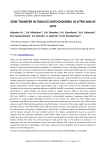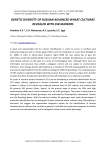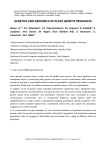Статьи журнала - Журнал стресс-физиологии и биохимии
Все статьи: 984

Gas exchange characteristics and water use efficiency in eucalyptus clones
Статья научная
The Institute of Forest Genetics and Tree Breeding, Coimbatore, India functioning under the Indian Council of Forestry Research and Education, Dehara Dun, has a long term systematic tree improvement programme in Eucalyptus spp. aimed to enhancing productivity and screening of clones for site specific. In the process, twenty four clones of Eucalyptus spp. were studied for the physiological parameters and water use efficiency from the established clonal trials. It also provides valuable information for establishing plantations at different geographic locations. Considerable variations were observed when the selected 24 clones of Eucalyptus spp. were subjected to physiological and WUE studies. The clones of C-188, C-186, C-14, C-10, C-123 and C-19 are falls in one cluster and the water use efficiency values are lower when compared to other clones and these clones are ranked first for high water use efficient clones for better productivity. Further, the clonal variation in physiological parameters and water use efficiency are discussed in detail in this article and clones suitable for large scale planting with higher productivity and WUE.
Бесплатно
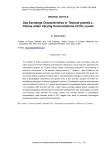
Статья научная
The Institute of Forest Genetics and Tree Breeding, Coimbatore, India functioning under the Indian Council of Forestry Research and Education, Dehara Dun, has a long term systematic tree improvement program for Tectona grandis aimed to enhancing productivity and screening of clones for site specific. In the process, twenty clones of T. grandis L. were studied for the physiological parameters and water use efficiency with reference to the elevated CO 2 levels. CO 2 enrichment studies in special chambers help in understanding the changes at individual level, and also at physiological, biochemical and genetic level. It also provides valuable information for establishing plantations at different geographic locations. Considerable variations were observed when the selected 20 clones of T. grandis were subjected to physiological studies under elevated CO 2 conditions (600 and 900 mol mol -1). Eight clones exhibited superior growth coupled with favorable physiological characteristics including high photosynthetic rate, carboxylation and water use efficiency under elevated CO 2 levels. Clones with minimal variation in physiological characteristics under elevated levels of CO 2 suggest their ability to overcome physiological stresses and adapt to varying climatic conditions.
Бесплатно
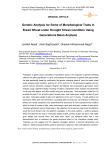
Статья научная
Perception of genes action controlling of quantitative traits is very important in genetic breeding methods the plant populations. to study and estimate the parameters of genetic and appointment the best genetically model for justification the genetic changing some of traits the bread wheat under drought stress condition, parents (P1 & P2) and F3, F4, F5 generations together the four control cultivars (Kharchia, Gaspard, Moghan and Mahuti) were evaluated by generation mean analysis using a agoment design including six blocks. Generation mean analysis was performed for all traits with Mather and Jinks model using joint scaling test. Three parameter model [m d h] provided the best fit for all traits expect harvest index, main spike grain weight, number of grain per plant, Total spike weight of plant with significant at 5% and 1% levels. Though additive and dominance effect both had interfered in controlling often the traits but with attention to difference effects and variety component was determined that dominance is more impressive than additive effect for traits of number of tiller, main spike weight, grain yield and grain number of main spike. Therefore will benefit using of these traits in the collection and to improve these traits hybridization would be much efficient than the selection strategies. In this study additive × additive epistasis effect only observed for traits of Total spike weight of plant, number of grain per plant, main spike grain weight and harvest index and other traits hadn't any epistasis effect that it was demonstration lack of existence the genes reciprocal effect in the inheritance studied traits. Therefore we can suggest that the selection strategies perform in terminal generations and additive × additive epistasis effect would be confirmed in selection under self-pollination condition.
Бесплатно

Genetic determination of the nitrogen supply of spring wheat (Triticum aestivum L.)
Статья
Бесплатно
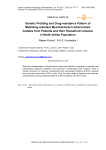
Статья научная
Molecular characterization of Mycobacterium tuberculosis (MTB) is important to understand the pathogenesis, diagnosis, treatment, and prevention of tuberculosis (TB). However, there is limited information on molecular characteristics and drug-resistant patterns of MTB in patients with pulmonary tuberculosis (PTB) in India. Thus, this study aimed to determine the molecular characteristics and drug resistance patterns of MTB in patients with PTB in India.
Бесплатно
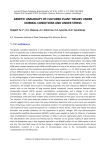
Genetic variability of cultured plant tissues under normal conditions and under stress
Статья
Бесплатно
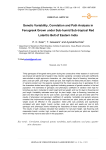
Статья научная
Thirty genotypes of fenugreek were grown during two consecutive winter seasons in sub-humid sub-tropical red lateritic belt of eastern India. Genetic variability, correlation and path coefficients were studied on eight agronomic characters, viz., plant height, days to flowering, branches per plant, pods per plant, pod length, seeds per pod, test weight and seed yield per plant. Analysis of variance pooled over the seasons revealed that the mean squares due to genotypes for all the characters studied were highly significant indicating presence of genetic variation in the test population. The estimates of genotypic and phenotypic coefficient of variation were high for branches per plant, moderate for plant height and test weight, and low for days to flowering and pod length. Heritability estimates were high for plant height, days to flowering, branches per plant and test weight and low for pod number, pod length, seeds per pod and seed yield The results of phenotypic and genotypic coefficient of variability, heritability and genetic advance revealed that improvement through selection for branches per plant, pods per plant and test weight would be effective in this population. Seed yield was positively and significantly correlated with plant height, branch number, pods per plant and seeds per pod at both genotypic and phenotypic levels indicating the importance of these characters for seed yield. The results of path analysis indicated that selection for tall plant height, late flowering with reasonable branch number, high number of seeds per pod and pods per plant are important which will help improve seed yield in this population.
Бесплатно

Статья научная
The post-translational modification involves protein degradation which helps to degrade the overexpressed proteins in plants. This includes the process of ubiquitination and deubiquitination where the targets attached with the substrates are cleaved and can play a major role in plant-pathogen interactions. By 26S/proteasome pathway, the pathogens are targeted for the defense of the plant and thus the proteases involved in the process are taken for the study. The study involves the digital expression of the genes which helps to infer the gene expression among various important plant tissues which helps to manifest the responses against the pathogenic stresses. Ubiquitin-specific protease are seen to expressed maximum among the plants species taken for study and thus it can be generalized that these protease genes can help to combat against the biotic stresses in certain tissue specific regions as their own immune response.
Бесплатно
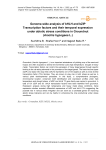
Статья научная
Groundnut ( Arachis hypogaea L.), is an important subsistence oil yielding crop of the semi-arid tropics and often exposed to several environmental cues (high temperature, drought & heavy metal). Transcription factors can control the expression of many target genes through specific binding to the cis-acting elements in the promoters of the target genes. The basic leucine zipper (bZIP) and basic helix-loop-helix (bHLH) represents one of the largest as well as most diverse transcription factor (TFs) families. They are known to play role in both stress as well as in various plant developmental processes. In this study, a comprehensive phylogeny, chromosomal location, conserved motif identification and expression profiles under high temperature and drought stress. of bZIP and bhLH TF gene family was carried in groundnut. A total of 151 bZIP and 39 bHLH transcription factors have been identified from groundnut. Expression analysis during high temperature and heavy metal stress conditions. Gene expression studies revealed differential expressions of bZIP and bhLH TFs suggesting the possible role in various stress mitigation and can serve as a candidate genes for improving abiotic stress tolerance and can be helpful in enhancing the crop productivity under stress conditions.
Бесплатно
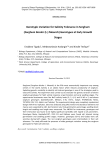
Статья научная
Sorghum ( Sorghum bicolor L. Moench) is the fifth most economically important crop among cereals in the world. Salinity is an abiotic factor which reduces productivity of sorghum. Exploiting genetic variability to identify salt tolerant genotype is one of the strategies used to overcome salinity. Pot experiment was carried out to evaluate the genetic variation of eleven sorghum genotypes for NaCl salinity response at germination and early seedling stages. The experimental treatments were five NaCl salinity levels (0, 2, 4, 8, and 16 dS m -1) and eleven sorghum genotypes (Gambella1107, Melkam, S-35, ESH-2, Gobye, 97MW6130, Meko, 76T1#23, ICSV-111, Abshir and Teshale). The experimental design was completely randomized design with three replicates. Data was analyzed using SAS (version 9.0) statistical software and means were separated by LSD. Germination rate, final germination percentage, seedling shoot length and seedling root length were measured. The ANOVA for treatments, genotypes and their interaction was found to be highly significant (p
Бесплатно
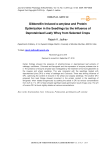
Статья научная
Earlier findings showed the presence of phytohormones in deproteinised leaf extracts of cabbage, cauliflower, Colocasia and fenugreek and the expression of enzyme protease due to it. The presence of enzyme amylase was investigated by the treatment of hormone gibberellin to the cowpea and wheat seedlings. This was compared with the seedlings treated with deproteinised juice (DPJ) or whey of cabbage and Colocasia . There was striking influence of DPJ, optimizing the content of enzyme in the wheat and cowpea seedlings. The another DPJ prepared from beet foliage showed increment in the protein content in the seedlings of fenugreek, when treated exogenously by soaking the seeds in DPJ at various concentrations from 0.25 to 1 %. DPJ of beet showed significant seed germination result of bajra crop. The pH of lucerne DPJ is found slightly alkaline at various concentrations.
Бесплатно
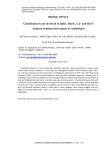
Glutathione is not involved in light-, dark-, Ca- and H2O2-induced stomatal movement in Arabidopsis
Статья научная
Glutathione (GSH), is a thiol-containing tripeptide, maintains redox homeostasis in plants under normal and stressful conditions. In this study, we investigated whether GSH involved in light-, dark-, Ca- and H2O2-induced stomatal movement in Arabidopsis. Application of GSH and a GSH decreasing chemical (CDNB; 1-chloro-2,4-dinitrobenzene) did not affect stomatal aperture in guard cells of Arabidopsis. Dark induced stomatal closure and light induced stomatal opening but pre-treatment of GSH and CDNB did not alter dark- and light-induced stomatal aperture. Treatment of guard cells with Ca and H2O2 did not affect GSH contents in guard cells but induced stomatal closure in both wild type and chorinal-1 (ch1-1) mutant plants. In addition, pre-treatment of GSH and CDNB did not affect Ca- and H2O2-induced stomatal closure in both plants. Taken together these results suggest that GSH might not directly affect light-, dark-, Ca- and H2O2-induced stomatal movement in guard cells of Arabidopsis.
Бесплатно
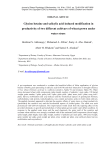
Статья научная
A pot experiment was conducted to evaluate the beneficial effect of foliar application of glycine betaine (10mM), grain presoaking in salicylic acid (0.05 M) and their interaction on drought tolerance of two wheat (Triticum aestivum L.) cultivars (sensitive, Sakha 94 and resistant, Sakha 93). Water stress decreased wheat yield components (spike length, number of spikelets / main spike, 100 kernel weight, grain number / spike, grain yield / spike, grain yield / plant, straw yield / plant, crop yield / plant, harvest, mobilization and crop indices) and the biochemical aspects of grains(grain biomass, carbohydrates, total protein, total phosphorus, ions content and amino acids) in both wheat cultivars. The applied chemicals appeared to alleviate the negative effects of water stress on wheat productivity (particularly the sensitive one) and the biochemical aspects of yielded grains. The effect was more pronounced with GB+SA treatment. This improvement would result from the repairing effect of the provided chemicals on growth and metabolism of wheat plants grown under water deficit condition. In response to the applied water stress and the used chemicals, the grain yield of the sensitive and resistant wheat cultivars was strongly correlated with all the estimated yield components (shoot length, spike length, plant height, main spike weight, number of spikelets per main spike, 100 kernel weight, grain number per spike, grain weight per plant, straw weight per plant, crop yield per plant, harvest, mobilization and crop indices).
Бесплатно
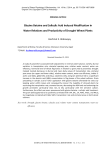
Статья научная
A study of parameters associated with adjustments in internal water balance, namely: diurnal variation in transpiration rate, stomatal opening area, relative water content, water use efficiency, hormonal level of wheat flag leaves in relation to grain yield is presented. Drought induced marked decreases in diurnal and mean daily values of transpiration rate, stomatal pore areas (on upper and lower sides), relative water content, water use efficiency, indole-3-acetic acid (IAA), gibberellic acid (GA 3), cytokinins (CK s) and grain yield but led to a significant increase in the abscisic acid (ABA) concentration in flag leaves of the wheat cultivars. Grain presoaking in salicylic acid or foliar application with glycine betaine alleviated the stress by keeping water within leaves and consequently recover the turgidity of stressed plants by restricting the transpiration rate, stomatal closure, decreasing the ABA level and enhancing the growth promoters particularly (IAA, GA 3 & CK s) particularly with the sensitive cultivar. Furthermore, the effect was more pronounced with glycine betaine + salicylic acid treatment. The grain yield appeared to be positively correlated with IAA, GA 3, CK, RWC, WUE G and WUE B but negatively correlated with ABA, SWD, transpiration rate and stomatal areas on both wheat cultivars.
Бесплатно
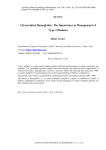
Glycosylated hemoglobin: the importance in management of type 2 diabetes
Статья обзорная
Type 2 diabetes is a major public health problem with high and increasing prevalence, morbidity and mortality. The association between diabetes and microvascular and macrovascular complications is well known besides, tight glycemic control is a necessity. HbA1Chas clinically been used since 1980s as a gold standard for monitoring glycemic control and predicting of diabetic complications. The present review article was prepared by computerized sources of literature searches 2000 - 2009. The history of Hemoglobin A1C, its assay techniques, optimal A1C targets, its reliability in control of diabetic complications, limitations of test results and its importance in control of diabetes patients and their complications are discussed.
Бесплатно
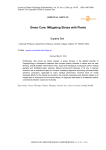
Green care: mitigating stress with plants
Статья научная
Ecotherapy, also known as nature therapy or green therapy, is the applied practice of Ecopsychology a therapeutic treatment that involves outdoor activities in nature such as care farming, animal-assisted interventions (AAI), social and therapeutic horticulture (STH), healing gardens and facilitated green exercise. Natural environment because of its role in species evolution has a restorative impact on humans increasing happiness promoting neurotransmitter serotonin production, applicable to many medical phenomena. Humans have an innate biological affinity for the natural environment -the biophilia hypothesis and Biophilic design is an integral part of restorative environmental design , an approach that seeks to re-establish positive connections between nature and humanity.
Бесплатно
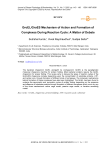
GroEL/GroES mechanism of action and formation of complexes during reaction cycle: a matter of debate
Статья обзорная
The bacterial chaperonin GroEL alongwith its cochaperonin GroES is the paradigmatic molecular chaperone machine for protein folding. Most bacterial proteins require the GroEL chaperonin for proper folding. This review aims to discuss the types of reaction cycles of the GroEL/ES chaperone complex depending upon the concentration of substrate proteins, ATP, and certain ions, through formation of different kinds of complexes. The molecular mechanisms behind formation of these complexes have also been highlighted. The GroEL has been found to undergo the asymmetric and symmetric cycles of protein folding depending on the presence and absence of substrate proteins through formation of different complexes which occur by any of the three mechanisms: active cage model, passive cage model, or iterative annealing model.
Бесплатно

